Pesto GenovesePesto Genovese
Il suo fresco profumo è inconfondibile. Il sapore lo è ancora di più. La sua storia forse è meno conosciuta e allora proviamo a vederla brevemente insieme.
Il pesto come lo conosciamo oggi può essere fatto risalire ai primi decenni del XIX secolo, ma le sue origini sono facilmente individuabili nel “Moretum”, impasto spalmabile descritto, probabilmente da Virgilio, nel 1° secolo a.C. nella raccolta “Appendix Vergiliana”: preparato nel mortaio (da cui il nome) pestando erbe, formaggio, sale, olio, aceto e non di rado noci.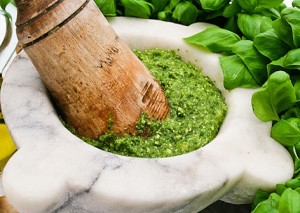
Diffusa poi nel Medioevo era a Genova “l’agliata”, salsa popolare estremamente nota ai tempi della Repubblica Marinara; questa salsina a base di battuta di noci, aglio e aceto era la prediletta dei navigatori che ne ingerivano grandi quantità, soprattutto come alleata durante la navigazione per scongiurare pericoli derivanti dalle precarie situazioni igieniche.
L’introduzione dei pinoli, o meglio la codifica della prima ricetta del pesto, risale a Giovanni Battista Ratto che nel suo ricettario introduce i pinoli e dettaglia la preparazione:
“Prendete uno spicchio d’aglio, basilico (baxaicö) o in mancanza di questo maggiorana e prezzemolo, formaggio olandese e parmigiano grattugiati e mescolati insieme e dei pignoli e pestate il tutto in mortaio con poco burro finchè sia ridotto in pasta. Scioglietelo quindi con olio fine in abbondanza. Con questo battuto si condiscono le lasagne e i gnocchi (troffie), unendovi un po’ di acqua calda senza sale per renderlo più liquido”.
Può far alzare più di un sopracciglio il suggerimento di utilizzare la maggioranza ed il prezzemolo, così come il formaggio olandese o il burro; ebbene non ci si deve stupire se consideriamo che nel tempo in cui questo ricettario vide la luce il basilico era sì abbondante, ma stagionale. Riguardo il formaggio olandese è logico presupporre che i commerci con i paesi del nord non abbiano portato a scambi unicamente culturali ma anche gastronomici. La non differenziazione invece del parmigiano è cosa ovvia, dato che i relativi consorzi di Parmigiano Raggiano e Grana Padano appartengono alla storia recente, agli anni 50 del XX secolo.
È fuori dubbio che il pesto si sia sposato benissimo con altre tipicità genovesi anche antiche come la pasta secca, la cui presenza in territorio genovese è testimoniata già nel 1279 dal testamento di tale Bastone che ai figli lasciava un bariscela de macaronis; sono poi assolutamente rilevanti, anzi trainanti, della cultura culinaria genovese e ligure gli accompagnamenti del pesto alle paste fresche, come le trofie, le trofiette e i croxetti. L’aggiunta di patate e fagiolini rendeva e rende il piatto più completo, soprattutto nel caso della pasta secca, mentre nel caso delle trofie l’uso di aggiungere patate è solitamente non contemplato.
Parlare però di ricetta “terminata” sarebbe impreciso: un tempo la maggior presenza di aglio a discapito del basilico sia per scelte di tradizione come abbiamo visto sia di gioventù della ricetta stessa, rendendo, secondo le parole di Gavotti, il tutto un po’ “maleducato” (cit. La cucina e i vini di Liguria). Oggi certo le quantità sono cambiate, affinando ed equilibrando gli ingredienti per ottenere un pesto delicato e gentile.
L’ingrediente principale è oggi giustamente il basilico, rigorosamente genovese di Prà, dalla foglia piccola ed allungata. L’olio poi, fondamentale che sia extra vergine e non amaro né troppo fruttato, pena la non ottimale riuscita della ricetta; il basilico genovese e l’olio della riviera ligure avendo ottenendo la DOP sono gli ideali per la ricetta. Ma questo non basta: si consiglia l’utilizzo di agli di Vessalico (IM), delicato e particolare, sale grosso di Cervia e pinoli italiani. Parmigiano Reggiano DOP, Grana Padano DOP e Pecorino Fiore Sardo DOP completano la ricetta.
Per origine e per diffusione la pasta al pesto ha sempre avuto le caratteristiche di piatto popolare e risente anch’esso dell’effetto positivo dovuto alla riscoperta dei sapori tradizionali e degli ingredienti naturali che sta rivoluzionando il settore dell’alimentazione; a livello casalingo viene ancora usato il mortaio di marmo con il pestello rigorosamente in legno, mentre a livello industriale i frullini sono una scelta obbligata. È superfluo dire che a livello artigianale la ricetta viene modificata praticamente di famiglia in famiglia, sia nelle quantità sia negli ingredienti dove possono fare la loro comparsa le noci ( e i motivi come abbiamo imparato sono facilmente individuabili) oppure formaggi diversi, come la ricotta.
Sia quel che sia, il Pesto ha raggiunto una popolarità mondiale, sia per le migrazioni dei genovesi sia per la sua innata e indiscutibile bontà. Diffusasi ovunque, dai quartieri genovesi di Buenos Aires agli Stati Uniti, questa salsa genovese è oggi la seconda più venduta la mondo. Non immune da modifiche e storpiature la ricetta originale è oggi oggetto di tutela del Consorzio del Pesto Genovese, promosso da Regione Liguria e dall’associazione dei produttori, con il fine di, usando le parole del Presidente Della Gatta, “tutelare la ricetta tradizionale del pesto, con tutti i suoi ingredienti di qualità ed in primis l’utilizzo del basilico, ovviamente ligure”.
PESTO GENOVESE o PESTO “ALLA” GENOVESE?
Partiamo innanzitutto con la definizione corretta perchè in commercio, con la dicitura di pesto “alla” genovese, spesso si trova di tutto: pesto preparato con l’aggiunta di ricotta, anacardi, olio di semi e molti altri ingredienti che poco, anzi nulla, hanno a che vedere con la nostra salsa.
E’ proprio quel “alla genovese” che deve mettervi in guardia e portarvi a leggere bene l’etichetta del prodotto, perché “alla” in questo caso vuol dire tutto e niente.
Solo “PESTO GENOVESE” indica la vera ricetta del pesto tradizionale con i 7 ingredienti contemplati dal Consorzio e garanti di un antico retaggio regionale, quali: Basilico genovese DOP, Olio extravergine d’oliva, possibilmente della Riviera Ligure, Parmigiano Reggiano (con variante Grana Padano) e Pecorino (fiore Sardo),Pinoli, Aglio, Sale.
INGREDIENTI PER CONDIRE 600 GR. DI PASTA
Basilico Genovese DOP (Ocimum Basilicum) 50 grammi di basilico a foglia piccola.
Il Basilico, possibilmente giovane e fresco, deve essere quello che presenta i requisiti qualitativi e varietali previsti dal Disciplinare.
Olio Extravergine d’Oliva mezzo bicchiere, possibilmente della Riviera Ligure o prodotto in regioni italiane contigue.
Formaggio grattugiato: Parmigiano Reggiano DOP (con variante Grana
Padano) 6 cucchiai da cucina, Pecorino DOP (Fiore Sardo) 2 cucchiai da cucina
Aglio 2 spicchi
Pinoli 1 cucchiaio da cucina, devono essere prodotti nell’area mediterranea.
Noci (facoltative, in sostituzione ai pinoli), ottenute da “Juglans regia” devono essere di origine europea
Sale grosso qualche grano
PREPARAZIONE DEL PESTO GENOVESE
Per fare il vero Pesto genovese occorrono un mortaio di marmo e un pestello
in legno, tanta diligenza e pazienza.
Per prima cosa bisogna lavare in acqua fredda il basilico, poi metterlo ad asciugare su un canovaccio, nel frattempo nel mortaio si deve pestare uno spicchio d’aglio ogni trenta foglie di basilico, la ritualità sta anche nelle dosi.
L’aglio deve essere dolce, non deve prevalere pur facendosi sentire nel sottofondo…insomma non può mancare! E non deve mancare neppure il sale grosso, aggiungetene qualche grano.
A questo punto, ma non tutte, vanno aggiunte le foglioline di basilico e si inizia con un dolce movimento rotatorio e prolungato a pestarle nel mortaio.
Ricordatevi che gli oli essenziali del basilico sono conservati nelle venuzze delle sue foglie e che per ottenere il miglior gusto, bisogna non pestare gravemente ma ruotare leggermente il pestello in modo da stracciare, non tranciare, le profumate foglioline.
Quando il basilico stilerà un liquido verde brillante sarà il momento di aggiungere i pinoli, una manciata.
I pinoli che ammorbidiranno e amalgameranno la salsa, le regaleranno quel bouquet gentile che fa da contraltare all’aglio, sono un di più, il tocco d’artista. Quelli di qualità migliore sono nazionali e, naturalmente, sono più costosi, ma in questa occasione vogliamo sfatare il mito della parsimonia dei genovesi e sceglieremo per il meglio.
E’ giunto il momento dei formaggi: parmigiano reggiano e pecorino sardo, entrambi DOP, adeguatamente stagionati. Ed infine l’olio extravergine d’oliva, versato a goccia, naturalmente italiano dal sapore non particolarmente aggressivo, non particolarmente intenso, ideale per sposare tutti gli ingredienti senza sopraffarli.
Un’ultima raccomandazione:
la lavorazione deve avvenire a temperatura ambiente e deve terminare nel minor tempo possibile per evitare problemi di ossidazione. A questo punto il Pesto è pronto e può essere utilizzato per condire le troffie, le trofiette, le trenette avvantaggiae, i mandilli de saea e può essere aggiunto, per dare gusto, al minestrone di verdure.
Oggi, nell’era della fretta, per fare un buon Pesto Genovese si usa anche il frullatore, ma la migliore soluzione è sempre quella… “all’antica” !
Il pesto può anche essere congelato fino al momento dell’ utilizzo.
Fonti: mangiareinliguria.it
pesto-genovese.it/Its fresh aroma is unmistakable. The taste is even more. His story is perhaps less known, and then let’s see it together briefly. Pesto as we know it today can be traced back to the first decades of the nineteenth century, but its origins are easy to find in the “Moretum” spreadable mixture described, probably by Virgil in the 1st century BC in the collection “Appendix Vergiliana”: prepared in the mortar (hence the name) pounding herbs, cheese, salt, oil, vinegar and often nuts.

Then widespread in the Middle Ages was in Genoa “the garlic sauce”, extremely popular sauce known at the time of the Maritime Republic; this sauce made batting nuts, garlic and vinegar was the favorite of the navigators who ingested large amounts, especially as an ally when navigating to ward off dangers arising from poor sanitation situations.
The introduction of the pine nuts, or better the encoding of the first pesto recipe dates back to Giovanni Battista Ratto that in his recipe book introduces the pine nuts and detailed the preparation:
“Take a clove of garlic, basil (baxaicö) or failing that marjoram and parsley, Dutch cheese and grated Parmesan cheese and mixed together and pine nuts and pounded all in a mortar with a little butter until it is reduced to pulp. Loose him then with fine oil in abundance. With this beaten are seasoned lasagna and gnocchi (troffie), enclosing a little hot water without salt to make it more liquid”.
May raise more then one eyebrows the suggestion to use marjoram and parsley, as well as the Dutch cheese or butter; Well, we do not be surprised if we consider that in the time when this recipe was born basil was so abundant, but seasonal. Regarding the Dutch cheese is logical to assume that the trade with the countries of the North have not led to trade only cultural but also culinary exchanges. The non-differentiation instead of parmesan is obvious, since the consortia of Parmigiano Reggiano and Grana Padano belong to recent history, the 50 years of the twentieth century.
There is no doubt that the pesto has married well with other typical Genoese also ancient as dried pasta, whose presence in the Genoa area is witnessed already in 1279 by the will of thatBastone that left to the children a “bariscela of macaroni”; are also absolutely relevant, indeed driving, of the culinary culture of Genoa and Liguria accompaniments of pesto with fresh pastries, like trofie, trofiette and croxetti. The addition of potatoes and green beans made and makes the plate more complete, especially in the case of dry pasta, while in the case of the use of trofie add potatoes is not usually contemplated.
But talk of recipe “finished” would be inaccurate: once time the greater presence of garlic at the expense of basil both for choices of tradition, as we have seen, and for the youth of the recipe itself, making it, in the words of Gavotti, all a bit ‘”rude “(cit. The kitchen and the wines of Liguria). Today certainly quantities have changed, sharpening and balancing the ingredients for a more gentle and kind pesto.
The main ingredient is today rightly the basil, rigorously Genoese from Pra, with small and elongated leaves. The oil then, essential that is both extra virgin and not bitter or too fruity, otherwise the non-optimal success of the recipe; Genoese basil and oil of the Ligurian Riviera having obtained the DOP are the ideals for the recipe. But this is not enough: we recommend the use of the Vessalico (IM) garlic, delicate and particular, the salt of Cervia and Italian pine nuts. Parmigiano Reggiano DOP, Grana Padano DOP and Pecorino Fiore Sardo DOP complete the recipe.
Due the origin and spread the pesto pasta has always had the characteristics of popular dish and also reflected the positive effect due to the rediscovery of traditional flavors and natural ingredients that is revolutionizing the food industry; at household level it is still used marble mortar with pestle made from wood, while in the industrial beaters are an obvious choice. Needless to say that at artisan level the recipe is changed practically from family to family, both in quantity and in the ingredients, where they can make their appearance nuts (and the reasons as we have learned are easily identifiable), or different cheeses, like cottage cheese.
Whatever happens, the Pesto has reached a worldwide popularity, both for migrations of the Genoese both for its innate and unquestionable goodness. Spread everywhere, from Genoese districts of Buenos Aires to the United States, this genovese sauce is now the second best selling in the world. Not immune from changes and crippling the original recipe is now the subject of protection from the Consortium of Pesto Genovese, promoted by Regione Liguria and by the producers, with, with all its quality ingredients and above all the use of basil, of course Ligurian.”
PESTO GENOVESE PESTO or “AT” GENOVESE?
Let’s start first with the correct definition because on the market, with the words of pesto “at” Genoese, often you can find anything: pesto prepared with the addition of ricotta cheese, cashew nuts, vegetable oil and many other ingredients that little, indeed nothing, have to do with our sauce. It ‘just that “at Genovese” that should warn you and bring you to carefully read the product label, because “at” in this case means everything and nothing. Only “PESTO GENOVESE” indicates the true traditional pesto recipe with 7 ingredients covered by the Consorzio and guarantors of an ancient regional legacy, such as DOP Genoese basil, extra virgin olive oil, possibly of the Italian Riviera, Parmigiano Reggiano (with variant Grana Padano) and Pecorino Fiore Sardo, pine nuts, garlic, salt.
INGREDIENTS FOR 600 GR. OF PASTA
Genovese basil (Ocimum basilicum) 50 grams of small basil leaves. The basil, possibly young and fresh, must be the one that has the minimum quality and variety provided for by the Regulations.
Extra Virgin Olive Oil ½ cup, possibly from the Ligurian Riviera or produced in the Italian adjacent regions.
Grated cheese: Parmigiano Reggiano DOP (with variant Grana Padano) 6
tablespoons
Pecorino DOP (Fiore Sardo) 2 tablespoons
2 garlic cloves
1 tablespoon pine nuts, must be produced in the Mediterranean. Nuts (optional, replacing the pine nuts), obtained from “Juglans regia” must be of European origin
Salt some grains
PREPARING PESTO GENOVESE
To do the real Pesto Genovese needed a marble mortar and wood pestle, such diligence and patience. First you need to wash in cold water the basil, then put it to dry on a towel, in the meantime in the mortar must crush a clove of garlic every thirty basil leaves, the ritual is even in doses. Garlic should be soft, should not prevail despite being heard in the background … so you can not miss!
It should not even miss the salt, add some grains. At this point, but not all, should be added the basil leaves and you start with a gentle and extended circular motion to crush them in a mortar. Remember that basil essential oils are preserved in the veins of the leaves and to get the best taste, you should not beat seriously but slightly rotate the pestle to tearing up, no shearing up, the scented leaves.
When the basil will draw a bright green liquid it’s time to add the pine nuts, a handful. The pine nuts that soften and amalgamate the sauce, to give that kind bouquet that is in contrast with garlic, are a must, the artist’s touch. Those of better quality are national and, of course, are more expensive, but on this occasion we want to dispel the myth of the frugality of the Genoese and choose for the best. Now is time of cheeses: Parmesan and pecorino cheese, both DOP, properly seasoned. And finally the extra virgin olive oil, poured drop by drop, of course Italian which flavor is not particularly aggressive, not particularly deep, ideal to marry all the ingredients without overwhelming.
One last recommendation:
Processing must take place at room temperature and must finish in the shortest possible time to avoid oxidation. At this point the pesto is ready and can be used to flavor troffie, trofiette, trenette avvantaggiate, the “mandilli de saea” and can be added to give flavor to vegetable soup. Today, in the era of hurry, to do a good Pesto Genovese is also used the blender, but the best solution is always the same … “the old”!
Pesto can be frozen until needed to use.
Sources: mangiareinliguria.it
pesto-genovese.it/





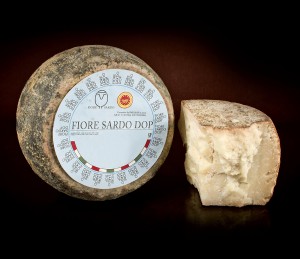
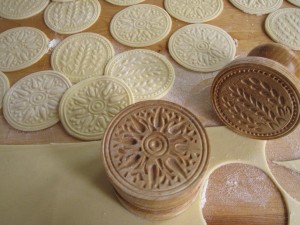
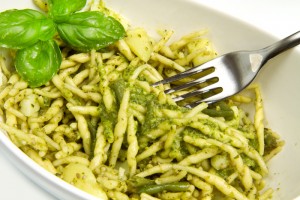
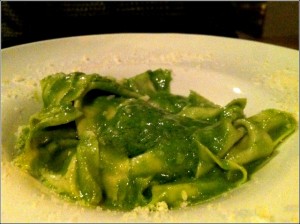
Leave a comment